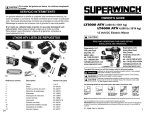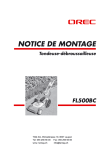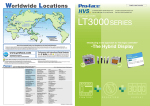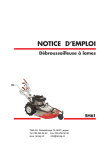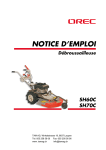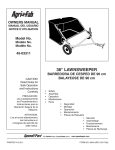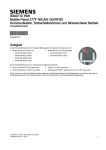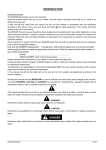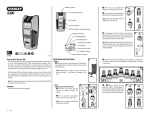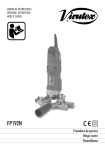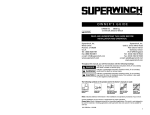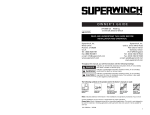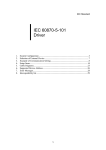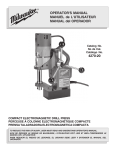Download OWNER`S GUIDE
Transcript
OWNER’S GUIDE LT3000 ATV 3000 Ib (1361 kg) 12 Volt DC Electric Winch CAUTION ! READ AND UNDERSTAND THIS GUIDE BEFORE INSTALLATION AND OPERATION. Superwinch, LLC. Winch Drive Putnam, CT 06260 U.S.A. Tel: (860) 928-7787 Fax: (860) 963-0811 e-mail: [email protected] www.superwinch.com Superwinch, Inc. Union Mine Road Pitts Cleave Tavistock, Devon PL19 OPW UK Tel: 44 (0) 1822 614101 Fax: 44 (0) 1822 615204 e-mail: [email protected] www.superwinch.com Throughout this manual, you will find notations with the following headings: Indicates an imminently hazardous situation which, if not avoided, will result in death or serious injury. ! DANGER ! WARNING ! CAUTION Indicates a potentially hazardous situation which, if not avoided, could result in death or serious injury. Indicates a potentially hazardous situation which, if not avoided, may result in minor or moderate injury. This notation is also used to alert against unsafe practices. The following symbols on the product and in the Owner's manual are used: Read Owner's Manual Always Use Handsaver Keep clear of winch, wire rope and hook while operating Never use winch to lift or move people Never use winch to hold loads in place Note: Indicates additional information in the installation and operation procedures of your winch. Correct installation of your winch is a requirement for proper operation. Please Note: Winch is designed primarily for intermittent applications. This winch is not designed to be used in industrial or hoisting applications and Superwinch does not warrant it to be suitable for such use. 87-10994 Rev - 3/1/10 1 GENERAL SAFET Y INFORMAT ION Your winch is a very powerful machine. If used unsafely or improperly, there is a possibility that property damage or personal injury could result. The responsibility for safe installation and operation of the winch and prevention of personal injury and property damage ultimately rests with you, the operator. There is no substitute for the use of good judgement and caution in operating a winch. ! WARNING The wire rope may break before the winch stalls. For heavy loads, use a pulley block to reduce the load on the wire rope. ! WARNING 1. Maximum working load capacity is on the wire rope layer closest to the drum. DO NOT OVERLOAD. DO NOT ATTEMPT PROLONGED PULLS AT HEAVY LOADS. Overloads can damage the winch and/or the wire rope and create unsafe operating conditions. FOR LOADS OVER 1,000 POUNDS (454 kg), WE RECOMMEND THE USE OF THE OPTIONAL PULLEY BLOCK TO DOUBLE LINE THE WIRE ROPE (Figure2). This reduces the load on the winch and the strain on the wire rope by approximately 50%. Attach hook to load bearing part. The vehicle engine should be running during winch operation. If considerable winching is performed with the engine off, the battery may be too weak to restart the engine. Single Line Double Line Figure 2 2. AFTER READING AND UNDERSTANDING THIS MANUAL, LEARN TO USE YOUR WINCH. After installing the winch, practice using it so you will be familiar with it when the need arises. 3. DO NOT“move” your vehicle to assist the winch in pulling the load. The combination of the winch and vehicle pulling together could overload the wire rope and the winch. 4. ALWAYS STAND CLEAR OF WIRE ROPE, HOOK AND WINCH. IN THE UNLIKELY EVENT OF ANY COMPONENT FAILURE IT‘S BEST TO BE OUT OF HARM‘S WAY. 5. INSPECT WIRE ROPE AND EQUIPMENT FREQUENTLY. A FRAYED WIRE ROPE WITH BROKEN STRANDS SHOULD BE REPLACED IMMEDIATELY. Always replace wire rope with the manufacturer‘s identical replacement part (see Replacement Parts List). Periodically check the winch installation to ensure that all bolts are tight. 6. USE HEAVY LEATHER GLOVES when handling wire rope. DO NOT LET WIRE ROPE SLIDE THROUGH YOUR HANDS. 7. NEVER WINCH WITH LESS THAN 5 TURNS of wire rope AROUND THE WINCH DRUM since the wire rope end fastener may NOT withstand full load. 8. KEEP CLEAR OF WINCH, TAUT WIRE ROPE AND HOOK WHEN OPERATING WINCH. Never put your finger through the hook. If your finger should become trapped in the hook, you could lose your finger. ALWAYS USE THE HANDSAVER when guiding the wire rope in or out (See Figure 3) . 11. NEVER USE YOUR WINCH FOR LIFTING OR MOVING PEOPLE. 12 .Your winch is not intended for overhead hoisting operations . 13 .AVOID CONTINUOUS PULLS FROM EXTREME ANGLES as this will cause the wire rope to pile up on one end of the drum (Figure 6). This can jam the wire rope in the winch, causing damage to the rope or the winch. Figure 6 Figure 3 9. NEVER HOOK THE WIRE ROPE BACK ONTO ITSELF because you could damage the wire rope. Use a nylon sling (Figure 4). Wrong Right 14. NEVER OBSCURE THE WARNING INSTRUCTION LABELS. 15 .Always operate winch with an unobstructed view of the winching operation. Wrong Right Figure 4 10 .It is a good idea to lay a heavy blanket or jacket over the wire rope near the hook end when pulling heavy loads (Figure 5). If a wire rope failure should occur, the cloth will act as a damper and help prevent the rope from whipping. 16. Equipment such as tackle, hooks, pulley blocks, straps, etc. should be sized to the winching task and should be periodically inspected for damage that could reduce their strength. 17 .NEVER RELEASE FREESPOOL CLUTCH WHEN THERE IS A LOAD ON THE WINCH. 18.NEVER WORK ON OR AROUND THE WINCH DRUM WHEN WINCH IS UNDER LOAD. 19.DO NOT OPERATE WINCH WHEN UNDER THE INFLUENCE OF DRUGS, ALCOHOL OR MEDICATION. Figure 5 2 3 20. ALWAYS DISCONNECT WINCH POWER LEADS TO BATTERY BEFORE WORKING IN OR AROUND THE WINCH DRUM so that the winch cannot be turned on accidentally. 21. When moving a load, slowly take up the wire rope slack until it becomes taut. Stop, recheck all winching connections. Be sure the hook is properly seated. If a nylon sling is used, check the attachment to the load. 22. When using your winch to move a load, place the vehicle transmission in neutral, set vehicle brake, and chock all wheels. 23. DO NOT USE THE WINCH TO HOLD LOADS IN PLACE. Use other means of securing loads such as tie down straps. 24. USE ONLY FACTORY APPROVED SWITCHES, REMOTE CONTROLS AND ACCESSORIES. Use of nonfactory approved components may cause injury or property damage and could void your warranty. 25. DO NOT MACHINE OR WELD ANY PART OF THE WINCH. Such alterations may weaken the structural integrity of the winch and could void your warranty. 26. DO NOT CONNECT WINCH TO EITHER 110V AC HOUSE CURRENT OR 220V MAINS AS WINCH BURNOUT OR FATAL SHOCK MAY OCCUR. 27. Never allow shock loads to be applied to winch or wire rope. 28. Use caution when pulling or lowering a load up and down a ramp or incline. Keep people, pets and property clear of the path of the load. 4 4 INSTALLATION Correct installation of your winch is required for proper operation. Step (1) Disconnect the vehicle battery leads from the battery. Step (2) Secure winch (Figure) to mounting plate or structural support using the M8 x 1.25 x 30mm mount bolts, flat washers, and lock washers provided. Typical mount is to a flat secure surface capable of handling the required loads. Step (3) Remove bottom roller from the roller fairlead. Turn the freespool knob to disengage and pull a few inches of wire rope from the drum. Pass the wire end under the remaining roller, and then replace the bottom roller. Next secure the roller fairlead ( Figure 7) to the mounting roller plate or structural support using the M8 x 1.25 x 20mm bolts, flat washers, and lock washers provided. Do not substitute ! WARNING any strength grade weaker than ISO grade 8.8 ! Be sure that both WARNING the mounting plate and winch hardware have been properly tightened. No part of the vehicle ! CAUTION (skid plates, wiring, auxiliary lights, tires, ect.) should impede the operation of your Superwinch®. When mounting, check all vehicle and winch parts for free operation. Be sure that the winch mounting location does not significantly reduce ground clearance. This winch MUST be ! WARNING mounted with the wire rope in the underwind direction. Improper mounting could damage your winch and void your warranty. Use the supplied hardware and brackets to mount the handlebar switch. Mount the solenoid close to the battery, in the storage box, under the seat or frame. The location of the switch MUST not interfere with safe operation of the vehicle. Wiring MUST NOT come in contact with any moving parts or sharp edges, such as engine, suspension, brakes, exhaust, or steering. ! WARNING Figure 7 Route the Red wire from the handlebar switch to the ignition switch and connect to the wire that is powered when ignition is in the ON position ONLY. Route the two wires from the solenoid to the motor Figure 8. Route the two wires from the solenoid to the battery. Attach the circuit breaker to the end of the red wire. Wrap the circuit breaker with electrical tape to prevent accidental short circuits. Apply several layers of electrical tape where wiring may come into contact with sharp metal parts of the vehicle to prevent insulation abrasion or cutting. Attach the short circuit breaker wire to the battery positive terminal and reattach the terminal to the battery. Connect the remaining black solenoid wire to the battery negative terminal and connect the terminal to the battery. STEP (4) Turn the clutch knob to, Disengaged “Free” position as shown in Figure 10. Pull several feet of wire rope off the drum. Return the clutch knob back to the, “Engaged” position. Activate the winch in Cable Out momentarily to check drum rotation direction. If the drum rotates in the wrong direction, recheck your wiring. FREESPOOL OPERATION Turn the clutch knob to the, Disengaged “Free” position as shown in Figure 10. If there is a load on the wire rope, the clutch knob may not pull out easily. DO NOT FORCE THE CLUTCH KNOB. Release tension on the clutch by jogging out some of the wire rope. Release the clutch and pull out the wire rope and secure to anchor or load. Check that there are at least five (5) turns of wire rope left on the drum. Re-engage the drum by returning the clutch knob to the, “Engaged” position. (See Figure 10). 5 If the winch motor stalls, do not continue to apply power. ! Figure 8 Figure 6 21 INTERMITTENT DUTY Yellow – 6 ga. Red WINCH ATV MASTER WIRINGS 2 1 ATV main switch Blue – 6 ga. 6 ga. Black- Black Green Fuse Red Brown/Blue Black Black BATTERY Black – 6 ga. Green Blue Black Red optional remote control ATV wiring connection CAUTION SOLENOID to solenoid Green Black optional CIRCUIT BREAKER "+" An electric winch is like any other motor driven power tool such as an electric drill or saw. The electric motorshould not be allowed to become excessively hot. Normal precautions will extend the life of your motor. Keep the durations of pulls as short as possible. If the end of the motor becomes uncomfortably hot to touch, stop winching and allow the motor to cool down. For further information and complete warranty, visit our website. www.superwinch.com REPLACEMENT PARTS LIST Red – 6 ga. to circuit breaker 1 9 REMOTE SOCKET MOUNTING Figure 7 – Socket Assembly mounts from outside/in Ø.86” Ø 21.8mm 5 1.95” 49.5mm 1. Detemine the mounting location for the remote socket. 2. Drill three holes using the included dimensions as a guide. 3. Once the remote socket is mounted, route the jacketed green and black leads back to where the solenoid is mounted. Splice the red lead to a key controlled electrical wire on the ATV. 7 8 .18” 4.6mm 6 .98” 24.8mm 4 2 Clutch must be fully engaged before winching. Never engage clutch knob while drum is turning. ! CAUTION 3 9 Figure 10 Disengaged (Freespool) 6 Engaged Reference No. Description Part Number 1 2 3 4 5 6 7 8 9 Wire Rope Assy. Motor Assy. Drum Assy. Gearbox Assy. Solenoid Assy. Handlebar Rocker Switch Hand Held Remote Circuit Breaker Assy. Clevis Hook Assy. 1511F 87-12890 87-12891 87-12892 87-12893 87-12894 87-12895 87-22873-16 87-42615 7 MANUEL DU PROPRIÉTAIRE VTT LT3000 3000 lb (1361 kg) ! Treuil électrique 12 Volts CC ATTENTION VEUILLEZ LIRE ET COMPRENDRE CE GUIDE AVANT TOUTE UTILISATION OU FONCTIONNEMENT Superwinch, Inc. Union Mine Road Pitts Cleave Tavistock, Devon PL19 OPW UK Tél : 44 (0) 1822 614101 Fax : 44 (0) 1822 615204 e-mail : [email protected] www.superwinch.com Superwinch, LLC. Winch Drive Putnam, CT 06260 ÉTATS-UNIS Tél : (860) 928-7787 Fax : (860) 963-0811 e-mail : [email protected] www.superwinch.com Tout au long de ce manuel, vous trouverez des annotations avec les en-têtes suivants : Indique un danger imminent qui, s’il est ignoré, peut provoquer des blessures graves, voire mortelles. Indique une situation potentiellement dangereuse qui, si elle est ! AVERTISSEMENT ignorée, peut provoquer des blessures graves, voire mortelles. Signale une situation dangereuse éventuelle qui, si elle est ignorée, ! ATTENTION peut causer des blessures légères. Cette notation est aussi utilisée pour vous alerter contre des pratiques dangereuses. ! DANGER Les symboles suivants sur le produit et dans le manuel du propriétaire sont utilisés : Lisez le Manuel du Propriétaire Utilisez toujours un système de protection des mains Tenez-vous à l’écart du treuil, du câble et du crochet pendant le fonctionnement N’utilisez jamais le treuil pour soulever ou déplacer une personne N’utilisez jamais le treuil pour maintenir des charges en place Remarque : Indique des informations complémentaires sur l’installation et sur les procédures de fonctionnement de votre treuil. L’installation correcte de votre treuil est impérative pour un bon fonctionnement. Veuillez noter : Le treuil est principalement conçu pour des applications intermittentes. Ce treuil n’est pas conçu pour être utilisé dans des applications industrielles ou de levage, et Superwinch ne le garantit pas comme étant adapté à une telle utilisation. 8 INFORMATIONS GÉNÉRALES DE SÉCURITÉ Votre treuil est une machine très puissante. S’il n’est pas correctement utilisé en sécurité, des dommages matériels ou un accident peuvent se produire. Câble unique La responsa- ! AVERTISSEMENT bilité d’une installation et d’un fonctionnement accident et des dommages matériels vous incombent en dernier lieu, à vous, l’opérateur. Rien ne vaut l’utilisation du bon sens et d’être précautionneux en faisant fonctionner un treuil. Le câble peut ! AVERTISSEMENT se rompre avant que le treuil ne cale. Avec de lourdes la charge sur le câble. 1. La charge maximum de travail se trouve sur l’enroulement de câble le plus proche du tambour. NE SURCHARGEZ PAS LE TREUIL. N’EFFECTUEZ PAS DE LONGUES TRACTIONS SUR DES CHARGES ÉLEVÉES. Les surcharges peuvent endommager le treuil et/ou le câble, et créer des conditions de fonctionnement dangereuses. POUR DES CHARGES SUPÉRIEURES À 1000 LIVRES (454 kg), NOUS RECOMMANDONS L’UTILISATION D’UN PALAN OPTIONNEL POUR DOUBLER LE CÂBLE (FIGURE 2). Ceci réduit la charge sur le treuil et la contrainte sur le câble d’environ 50 %. Fixez le crochet à la partie portant la charge. Le moteur du véhicule doit être en fonctionnement pendant le treuillage. Si un grand nombre de treuillages est réalisé avec le moteur à l’arrêt, la batterie peut être trop faible pour redémarrer le moteur. 9 Câble double Figure 2 8. ÉLOIGNEZ-VOUS DU TREUIL, DU CÂBLE SOUS TENSION ET DU CROCHET EN FAISANT FONCTIONNER LE TREUIL. Ne mettez jamais vos doigts dans le crochet. Si un de vos doigts était pris dans le crochet, vous pourriez le perdre. UTILISEZ TOUJOURS LE SYSTÈME DE PROTECTION DES MAINS lorsque vous guidez le câble pour le sortir ou l’enrouler 2. APRÈS AVOIR LU ET COMPRIS CE MANUEL, APPRENEZ À UTILISER VOTRE TREUIL. Après avoir installé le treuil, exercez-vous sur 4. TENEZ-VOUS TOUJOURS À L’ÉCART DU CÂBLE, DU CROCHET ET DU TREUIL. DANS LE CAS PEU PROBABLE DE LA PANNE D’UN COMPOSANT, IL EST TOUJOURS PRÉFÉRABLE D’ÊTRE EN DEHORS DE LA ZONE DANGEREUSE. 5. INSPECTEZ FRÉQUEMMENT LE CÂBLE ET L’ÉQUIPEMENT. UN CÂBLE EFFILO CHÉ AVEC DES TORONS BRISÉS DOIT ÊTRE IMMÉDIATEMENT REMPLACÉ. Vous devez toujours le remplacer par un câble de remplacement identique du fabricant (reportez-vous à la liste de vous assurer que tous les boulons sont serrés. 6. UTILISEZ DES GANTS ÉPAIS EN CUIR en manipulant le câble. NE LAISSEZ PAS LE CÂBLE FILER ENTRE VOS MAINS. 7. LE TREUILLAGE DOIT TOUJOURS S’EFFECTUER AVEC 5 TOURS DU CÂBLE AUTOUR DU TAMBOUR dans la mesure où le système de serrage de l’extrémité du câble peut ne pas supporter une pleine charge. 12. Votre treuil n’est pas destiné à fonctionner comme un palan 13. ÉVITEZ DES TRACTIONS DE LONGUE DURÉE SOUS DES ANGLES EXTRÊMES, ce qui pourrait provoquer l’accumulation du câble sur un seul rait coincer le câble sur le treuil et endommager l’un ou l’autre. familiariser à son utilisation lorsque le besoin se présentera. 3. NE DÉPLACEZ PAS votre véhicule pour aider le treuil à tracter une charge. La traction du winch ajoutée à celle du véhicule peuvent surcharger le câble et le treuil. 11. N’UTILISEZ JAMAIS VOTRE TREUIL POUR SOULEVER OU DÉPLACER DES PERSONNES. - Figure 6 Figure 3 9. NE POSEZ JAMAIS LE CROCHET SUR LE CÂBLE LUI-MÊME, SINON VOUS POURRIEZ L’ENDOMMAGER. Utilisez une Incorrect Correct 14. LES ÉTIQUETTES D’INSTRUCTION ET D’AVERTISSEMENT DOIVENT TOUJOURS ÊTRE VISIBLES. 15. Faites fonctionner le treuil en ayant toujours la visibilité totale de l’ensemble des opérations de treuillage. Incorrect Correct Figure 4 10. C’est une très bonne idée que de recouvrir le câble avec une couverture ou une veste à proximité du crochet 5). En cas de rupture du câble, le vêtement agira comme un amortisseur et empêchera au câble de se comporter comme un fouet. Figure 5 16. Des équipements tels qu’un tirefort, crochet, palan, sangle, etc. doivent être convenablement dimensionnés pour la tâche et doivent être régulièrement inspectés à la recherche de détériorations pouvant réduire leur résistance. 17. NE DÉCRABOTEZ JAMAIS LORSQUE LE TREUIL EST EN CHARGE. 18. NE TRAVAILLEZ NI N’ÉVOLUEZ JAMAIS À PROXIMITÉ DU TAMBOUR DU TREUIL PENDANT QUE CE DERNIER EST EN CHARGE. 19. IL EST INTERDIT DE FAIRE FONCTIONNER LE TREUIL SOUS L’EMPRISE DE L’ALCOOL, DE DROGUES OU DE MÉDICAMENTS. 10 20. VOUS DEVEZ TOUJOURS DÉCONNECTER LES CÂBLES D’ALIMENTATION ENTRE LE TREUIL ET LA BATTERIE AVANT DE TRAVAILLER OU D’ÉVOLUER AUTOUR que le treuil ne soit mis sous tension par inadvertance. 21. Lorsque vous déplacez une charge, mettez lentement sous tension le câble jusqu’à obtention de son raidistoutes les connexions de treuillage. Assurez-vous que le crochet se trouve correctement en place. En cas d’utilisation d’une élingue en nylon, 22. Lorsque vous utilisez votre treuil pour déplacer une charge, la boîte de vitesse doit se trouver au point mort, le frein à main serré et toutes les roues bloquées. 23. N’UTILISEZ PAS LE TREUIL POUR MAINTENIR DES CHARGES EN PLACE. Utilisez un autre moyen de maintenir une charge comme des sangles d’arrimage. 24. UTILISEZ SEULEMENT DES CONTACTEURS, DES COMMANDES À DISTANCE ET DES ACCESSOIRES APPROUVÉS USINE. L’utilisation de composants non approuvés usine peut provoquer des blessures ou des dégâts matériels, et annuler la garantie. 25. VOUS NE DEVEZ NI SOUDER, NI USINER AUCUNE PIÈCE DU TREUIL. réduire l’intégrité structurelle du treuil et annuler la garantie 26. NE CONNECTEZ JAMAIS LE TREUIL À DU SECTEUR 110 OU 220 V DE LA MAISON, CE QUI AURAIT POUR EFFET DE DÉTRUIRE LE TREUIL OU DE PROVOQUER UNE ÉLECTROCUTION. 27. Ne permettez jamais qu’une charge de rupture soit appliquée au treuil ou au câble. 28. Soyez précautionneux en tractant ou en abaissant une charge sur une rampe ou un plan incliné. Éloignez les personnes, les animaux domestiques et les biens hors du passage de la charge. 11 INSTALLATION L’installation correcte de votre treuil est impérative pour un bon fonctionnement. Étape (1) Déconnectez les câbles sur la batterie du véhicule. Étape (2) montage ou sur un support structurel en utilisant les boulons de montage M8 x 1.25 x 30 mm, les rondelles plates et les rondelles de blocage fournis. Le montage capable de supporter les charges requises. Étape (3) Démontez le rouleau inférieur du guidecâble à rouleaux. Faites tourner le bouton du décrabotage pour désembrayer le tambour et tirer quelques pouces de câble. Faites passer l’extrémité du câble sous le rouleau restant et remettez en place le rouleau insur la plaque de montage ou sur un support structurel en utilisant les boulons de montage M8 x 1.25 x 20 mm, les rondelles plates et les rondelles de blocage fournis. Ne substituez aucun matériel par un article de résistance ISO inférieure à 8,8. ! AVERTISSEMENT Assurez-vous ! AVERTISSEMENT que la plaque treuil ont été correctement serrés. Aucune pièce du véhicule (plaque de protection, câblage, éclairage auxiliaire, pneus, etc.) ne doit entraver le bon fonctionnement de votre Super-winch®. ! DANGER fonctionnement de l’ensemble du véhicule et des pièces du treuil. Assurez-vous que l’emplacement de montage du treuil garde au sol. Ce treuil DOIT être monté avec le câble dans la direction du déroulement. Un montage incorrect peut endommager le treuil et annuler la garantie. ! AVERTISSEMENT Utilisez le matériel et les supports fournis pour monter le contacteur sur le guidon. Montez le solénoïde à proximité de la batterie dans le boîtier de rangement, sous le siège ou sur le châssis. L’emplacement du contacteur NE DOIT PAS interférer avec le bon fonctionnement du véhicule. Le câblage NE DOIT PAS entrer en contact avec des pièces en mouvement ou des éléments tranchants, comme le moteur, Figure 7 la suspension, les freins, l’échappement ou la direction. ! ! AVERTISSEMENT Faites cheminer le câble rouge entre le contacteur sur le guidon et le contacteur d’allumage, et connectez le câble alimenté SEULEMENT lorsque l’allumage est sur la position ON SEULEMENT. Faites cheminer les deux câbles depuis le solénoïde jusqu’au moteur, Figure 8. Faites cheminer les deux câbles depuis le solénoïde jusqu’à la batterie. Fixez le disjoncteur sur l’extrémité du câble rouge. Entourez le disjoncteur avec du courts-circuits accidentels. Appliquez plusieurs couches de ruban adhésif sur les emplacements où le câblage peut entrer en contact avec des parties d’éviter l’abrasion ou l’entaillage de l’isolant. Fixez le câble du disjoncteur sur la prise positive et connectez-la sur la borne positive de la batterie. Connectez le câble noir restant du solénoïde sur la prise négative et connectez-la sur la borne négative de la batterie. Étape (4) Tournez le bouton d’embrayage sur la position « Libre » de débrayage selon la pieds de câble hors du tambour. Remettez le bouton d’embrayage sur la position « Embrayée ». Activez momentanément le treuil sur la position Cable Out (sortie du du treuil. Si le tambour tourne dans la votre câblage. FONCTIONNEMENT EN DÉCRABOTAGE Tournez le bouton d’embrayage sur la position « Libre » de débrayage selon la en charge, le bouton d’embrayage peut LE BOUTON D’EMBRAYAGE. Libérez la tension sur l’embrayage en faisant avancer et reculer le câble. Libérez l’embrayage, tirez sur le câble au minimum sont enroulés autour du tambour. Embrayez à nouveau le tambour en positionnant le bouton d’embrayage sur « Engaged » (embrayé). (Reportez-vous à la 12 ! ATTENTION Figure 8 Figu re 6 son utilisation. CIRCUITO MAESTRO DEL VEHÍCULO Si l’extrémité du moteur devient arrêtez le treuillage et laissez le moteur se refroidir. Si le moteur du treuil cale, cessez 21 SERVICE INTERMITTENT RougeYellow 6–ga. 6 ga. 12 Contacteur ATV main ATV switch principal Blue – 6 ga. Noir6 ga. Noir Black Noir Green Fuse Fuse Rouge Red Brun/Bleu Brown/Blue BATTERIE BATTE RY Black ga. Noir-–66ga. Vert Bleu Black Rouge Red Télécommande optional remote control Un treuil électrique se comporte comme un autre outil tel qu’une scie ou une perceuse électrique. Le moteur électrique ne doit pas devenir trop chaud. Des précautions normales étendront la durée de vie de votre moteur. La durée des tractions doit être aussi courte que possible. TREUIL WINCH CÂBLAGE ATV ATV PRINCIPAL MASTE R WIRINGS Connexion ATV wiring câblage ATV connection SOLÉNOÏDE SOLENOID Green Noir CIRCUIT DISJONCTEUR BREAKER "+" to solénoïde solenoid Vers optional Pour de plus amples informations et une garantie complète, rendez-vous sur www.superwinch.com LISTE DES PIÈCES DE RECHANGE Red 6– ga. 6 ga. RougetoVers circuit breaker disjoncteur Figure99 − Le support se monte l’extérieur Figur e 7de – Socket versAssembly l’intérieur mount s Ø.86” Ø 21.8mm 7 1 1.95” 49.5mm 5 fr om outside/in MONTAGE DE LA PRISE DE TÉLÉCOMMANDE 1. Déterminez l’emplacement de montage de la douille de la commande à distance. 2. Percez trois trous en utilisant les dimensions incluses à titre de guide. 3. Une fois que le commutateur est monté, faites cheminer les câbles isolés vert et noir vers l’emplacement de montage du solénoïde. Épissez le câble rouge sur le câble de clé de contact électrique sur le VTT. L’embrayage doit être embrayé avant un treuillage. Ne jamais tourner le bouton d’embrayage quand le tambour est en rotation. 13 2 9 3 4 Figure 10 (crabot) 6 .98” 24.8mm ! ATTENTION Débrayé 8 .18” 4.6mm Embrayé Référence 1 2 3 4 5 6 7 8 9 Description Câble Moteur Tambour Boîte de vitesses Solénoïde Contacteur bascule guidon Télécommande Disjoncteur Crochet à chape N° Pièce 1511F 87-12890 87-12891 87-12892 87-12893 87-12894 87-12895 87-22873-16 87-42615 14 INSTRUCCIONES DE USO Guinche eléctrico de 12 Voltios de CC ! PRECAUCIÓN LT3000 ATV de 3000 libras (1361 Kg) LEA ATENTAMENTE ESTAS INSTRUCCIONES ANTES DE INSTALAR Y USAR EL EQUIPO. Superwinch, Inc. Union Mine Road Pitts Cleave Tavistock, Devon PL19 OPW UK Tel.: 44 (0) 1822 614101 Fax: 44 (0) 1822 615204 e-mail: [email protected] www.superwinch.com Superwinch, LLC. Winch Drive Putnam, CT 06260 EE.UU. Tel.: (860) 928-7787 Fax: (860) 963-0811 e-mail: [email protected] www.superwinch.com En este manual encontrará notas con los siguientes encabezamientos: Indica una situación de peligro inminente que si no se evita podría causar un accidente grave o incluso la muerte. Indica una situación potencialmente peligrosa que si no se evita ! ADVERTENCIA podría causar un accidente grave o incluso la muerte. Indica una situación potencialmente peligrosa que si no se evita ! PRECAUCIÓN podría causar un lesión leve o moderada. Esta nota se utiliza para advertir sobre el uso de métodos inseguros. ! PELIGRO En el producto y en el manual de instrucciones también se utilizan los siguientes símbolos: Lea las instrucciones de uso Use siempre un guiador manual Manténgase alejado del guinche, del cable y del gancho mientras lo usa No use el guinche para levantar ni mover personas No use el guinche para sostener cargas en su lugar Nota: Indica información adicional para la instalación y el uso del guinche. Para que el guinche funcione normalmente debe instalarse correctamente. Nota: El guinche está diseñado principalmente para uso intermitente. Este guinche no está diseñado para aplicaciones industriales o como grúa, y Superwinch no lo garantiza para dichos usos. 15 INFORMACIÓN GENERAL DE SEGURIDAD El guinche es una máquina muy potente que, si se utiliza de manera insegura o incorrecta presenta la posibilidad de causar daños materiales o accidentes personales. Es responsabilidad del usuario instalar y usar el guinche con seguridad y tomar precauciones para evitar daños materiales y accidentes personales. No hay reemplazo del sentido común y la prudencia para usar un guinche. ! ADVERTENCIA El cable podría romperse incluso antes de que el guinche se atasque. Para tirar de cargas pesadas, use un aparejo de poleas para reducir la carga en el cable. ! ADVERTENCIA 1. La máxima capacidad de carga está en la parte del cable enrollada más cerca del tambor. NO SOBRECARGUE EL GUINCHE NI INTENTE PROLONGAR LA TRACCIÓN DE CARGAS MUY PESADAS. La sobrecarga puede dañar el guinche y/o el cable y crear condiciones riesgosas de uso. PARA CARGAS DE MÁS DE 1.000 LIBRAS (454 Kg) RECOMENDAMOS EL USO DE UNA POLEA (OPCIONAL) PARA REDUCIR LA CARGA SOBRE EL CABLE (Figura 2). Esto reducirá la carga sobre el guinche y aproximadamente el 50% de la carga sobre el cable. Acoplar el gancho a una parte con capacidad de soportar carga. El motor del vehículo debe estar en marcha durante el uso del guinche. Si se usa intensamente el guinche con el motor detenido, la batería podría perder mucha carga para volver a arrancar el vehículo. Línea simple Línea doble Figura 2 2. LEA ATENTAMENTE ESTE MANUAL Y APRENDA A USAR EL GUINCHE. Después de instalar el guinche, practique para aprender a usarlo y estar preparado cuando llegue la necesidad de hacerlo. 3. NO mueva el vehículo para tratar de ayudar al guinche. La tracción conjunta del vehículo y del guinche podría sobrecargar el cable y también el guinche. 5. INSPECCIÓN EL CABLE Y EL EQUIPO FRECUENTEMENTE. SI EL CABLE TIENE HEBRAS CORTADAS, DEBE SER CAMBIADO INMEDIATAMENTE. Use el cable original del fabricante del equipo (véase la Lista de repuestos). Inspeccione periódicamente el pernos estén bien ajustados. 6. Maneje el cable CON GUANTES GRUESOS DE CUERO. NO DEJE QUE EL CABLE SE DESLICE EN SUS MANOS. 11. NO USE EL GUINCHE PARA LEVANTAR NI MOVER PERSONAS. 12. El guinche no es para levantamiento vertical de cargas. 13. EVITE LA TRACCIÓN CONTINUA EN ÁNGULOS MUY ABIERTOS ya que podría empujar las vueltas de cable hacia un extremo del tambor (Figura 6) y se atascará, causando daño al cable y al guinche. Figura 6 Figura 3 9. NUNCA HAGA UN LAZO CON EL CABLE ya que podría dañarse. Utilice una eslinga de nylon (Figura 4). 4. MANTENGASE ALEJADO DEL CABLE, DEL GANCHO Y DEL GUINCHE. EN CASO DE FALLA DE ALGÚN COMPONENTE ES MEJOR ESTAR A DISTANCIA. Incorrecto Correcto 14. NO OCULTE NI CUBRA LAS ETIQUETAS DE INSTRUCCIONES. 15. Use el guinche con total visibilidad del área de trabajo. Incorrecto Correcto Figura 4 10. Es aconsejable colgar una lona pesada sobre el cable, cerca del gancho, para tirar de cargas pesadas (Figura 5). Si el cable se cortara, la lona actuará como amortiguador para evitar el rebote del cable. 16. Los equipos auxiliares tales como ganchos, poleas, correas, etc. ciente para trabajar con el guinche. Inspeccionarlos periódicamente encuentran. 17. NUNCA DESACOPLE EL EMBRAGUE CUANDO HAYA UNA CARGA ACOPLADA AL GUINCHE. 18. NO SE ACERQUE AL TAMBOR DEL GUINCHE CUANDO LO ESTÁ USANDO. 7. NO USE EL GUINCHE CON MENOS DE VUELTAS de cable EN EL TAMBOR, podría NO soportar la carga total. 16 8. MANTÉNGASE ALEJADO DEL CABLE TENSIONADO Y EL GANCHO. Nunca ponga los dedos en el gancho ya que podría perderlos si le queda la mano atrapada. USE SIEMPRE UN GUIADOR EXTERNO DEL CABLE (véase Figura 3). Figura 5 19. NO USE EL GUINCHE CUANDO ESTÉ BAJO LA INFLUENCIA DE ALCOHOL, DROGAS O MEDICAMENTOS. 17 20. Para evitar el arranque accidental del guinche, CUANDO ESTÉ TRABAJANDO EN EL TAMBOR, DESCONECTE LOS CABLES DE CONEXIÓN A LA BATERÍA. 21. Al mover una carga mantenga el cable tirante. Deténgase y revise la que el gancho esté bien asentado. Si está usando una eslinga de nylon, la carga. 22. Al usar el vehículo para mover una carga, deje la transmisión en el punto neutral (punto muerto), aplique el freno de mano y coloque cuñas en las ruedas. 23. NO USE EL GUINCHE PARA SOSTENER CARGAS EN SU LUGAR. Utilice otros medios, tal como correas o sogas. 24. USE ÚNICAMENTE INTERRUPTORES, CONTROLES REMOTOS Y ACCESORIOS APROBADOS POR FÁBRICA. El uso de componentes no aprobados por fábrica podría causar accidentes personales y daños materiales, además de anular la garantía del equipo. 25. NO SUELDE NI MAQUINE NINGUNA PARTE DEL GUINCHE. Estas alteraciones pueden debilitar el guinche y anular los términos de la garantía. INSTALACIÓN El guinche debe ser correctamente instalado para que funcione bien. Paso (1) Desconecte los cables de la batería del vehículo. Paso (2) Monte el guinche (Figura) en la placa de montaje o estructura de soporte con los pernos M8 1.25 x 30 mm, arandelas planas y arandelas de seguridad suministradas. El montaje típico es sobre soportar la carga. Paso (3) Desmonte el rodillo inferior de la guía del cable, gire la perilla de la polea loca para desacoplarla y tire algunas pulgadas de cable del tambor. Pase el extremo del cable bajo el rodillo guía y vuelva a colocar guía del cable (Figura 7) a la placa de montaje o el soporte estructural con los pernos M8 x 1.25 x 20 mm, arandelas planas y arandelas de seguridad suministradas. No sustituya ningún componente con otro de resistencia menor a ISO 8.8. ! ADVERTENCIA ! ADVERTENCIA placa de montaje y los accesorios del guinche estén 26. NO CONECTE EL GUINCHE A 120 NI 220 VOLTIOS DE CA, YA QUE PODRÍA QUEMARSE E INCLUSO CAUSAR UNA ELECTROCUCIÓN LETAL. Ninguna parte del vehículo (patines, cables, luces auxiliares, neumáticos, etc.) debe impedir el funcionamiento normal del Superwinch®. Inspeccione todas las partes del vehículo y del 27. No deje que el guinche ni el cable se vean sometidos cargas repentinas de impacto. que el guinche no reduzca considerablemente la altura libre del vehículo sobre el suelo. 28. Tome precauciones al tirar o bajar una carga en una rampa o terreno inclinado. Mantenga el paso de la carga despejado de objetos, animales y personas. El guinche debe montarse con la salida y entrada del cable por debajo del tambor. El montaje incorrecto del cable dañará el guinche y anulará la garantía. 18 ! PELIGRO ! ADVERTENCIA Utilice los accesorios y ménsulas suministrados para instalar el interruptor de manubrio. Instale la solenoide cerca de la batería, en la caja de almacenamiento bajo el asiento o el chasis. El interruptor no debe interferir con la conducción normal del vehículo. El cableado NO DEBE estar en contacto con ninguna parte Figura 7 como el motor, la suspensión, los frenos, el escape o la dirección. ! ! ADVERTENCIA Lleve el cable rojo desde el interruptor de manubrio hasta la llave de encendido y conéctelo al cable que queda bajo voltaje cuando se gira la llave de contacto a la posición ON SOLO. Lleve los dos cables de la solenoide al motor (Figura 8) y conéctelos a la batería. Conecte al interruptor al cable rojo. Envuelva el interruptor con cinta aislante para evitar cortocircuitos accidentales. Aplique varias capas de cinta aislante en los lugares donde los cables puedan entrar del vehículo. Conecte el conductor del interruptor al terminal positivo de la batería y vuelva a conectar el borne de la batería. El cable negro de la solenoide debe conectarse al negativo de la batería antes de volver a conectar el borne negativo. Paso (4) Ponga la perilla del embrague en la posición Desacoplado (tal como se muestra en la Figura 10). Desenrolle varios pies de cable del tambor y vuelva a dejar el embrague acoplado. Mueva un momento el guinche en la dirección de salida de cable tambor. Si el tambor gira en sentido incorrecto, revise las conexiones eléctricas. FUNCIONAMIENTO CON POLEA LOCA Ponga la perilla del embrague en la posición Desacoplado (tal como se muestra en la Figura 10). Si hubiera una carga tirando del cable, la perilla podría no salir con facilidad. NO FUERCE LA sión en el cable para aliviar la carga en el embrague. Suelte el embrague y tire del cable para al menos cinco (5) vueltas de cable en el tambor. Ponga la perilla en la posición de embrague acoplado (véase la Figura 10). 19 Si el motor se calienta hasta el punto en que está demasiado caliente al tacto, interrumpa el trabajo y deje que el motor se enfríe. Si el motor del guinche se atasca, no continúe energizando el motor. ! PRECAUCIÓN Figura 8 Figure 6 CIRCUITO MAESTRO DEL VEHÍCULO 21 SERVICIO INTERMITENTE Rojocalibre 6 Yellow – 6 ga. 12 Interruptor ATV main principal switch del vehículo Blue – 6 ga. calibre 6 Negro- Negro Black Negro Green Fuse Fusible Marrón/Azul Brown/Blue Red Azul Black BABATERÍA TTERY Black– 6 ga.6 Negrocalibre Verde Rojo Red controlremote remoto optional control conexión ATV wiring al circuito connection CIRCUIT INTERRUPTOR BREAKER SOLENOIDE SOLENOID del vehículo Green Negro "+" LISTA DE REPUESTOS to solenoid a solenoide – 6 6ga. Rojo-Red calibre optional Para obtener más información y datos de la garantía, conéctese a www.superwinch.com Un guinche eléctrico es similar a cualquier otra herramienta eléctrica, tal como un taladro o una sierra. No debe permitirse que el motor se sobrecaliente. Tomando precauciones normales se prolongará la vida útil del motor. Mantenga la duración de la tracción con el guinche lo más corta posible. GUINCHE WINCH CIRCUITO MAESTRO VEHÍCULO ATV DEL MASTE R WIRINGS to al circuit breaker interruptor Figura9 9: El receptáculo se monta Figur e 7desde – Socketafuera hacia adentro Assembly mount s 7 Ø.86” Ø 21.8mm 5 1 1.95” 49.5mm fr om outside/in MONTAJE DE RECEPTÁCULO DE COMANDO A DISTANCIA 1. Determine la ubicación del receptáculo remoto. f 8 .18” 4.6mm 3. Con el receptáculo montado, lleve el cable (con conductores verde y negro) hasta la solenoide. Conecte el cable rojo a un conductor que reciba electricidad de la llave de arranque del vehículo. 6 .98” 24.8mm 3 El embrague debe estar acoplado antes de usar el guinche. Nunca tratar de colocar la perilla del embrague cuando el tambor está en movimiento. ! PRECAUCIÓN 9 Figura 10 Desacoplado (polea loca) 20 4 2 Acoplado Referencia 1 2 3 4 5 6 7 8 9 Descripción Cable Motor Tambor Reductor de engranajes Solenoide Interruptor de manubrio Control remoto Interruptor Gancho con retén Número de parte 1511F 87-12890 87-12891 87-12892 87-12893 87-12894 87-12895 87-22873-16 87-42615 21












